The
Victorian Era—An Age of Revivals
by
Bob Brooke
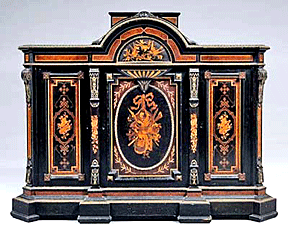 The American Victorian era
was such a long one–lasting from 1840 to 1900–that not one but
several distinct furniture styles appeared. Interestingly enough, each
of these styles borrowed from some period of the past, starting with
Medieval days and progressing to Renaissance and 18th-century Louis XVI.
But the Victorians managed to embellish everything made for their
houses. The American Victorian era
was such a long one–lasting from 1840 to 1900–that not one but
several distinct furniture styles appeared. Interestingly enough, each
of these styles borrowed from some period of the past, starting with
Medieval days and progressing to Renaissance and 18th-century Louis XVI.
But the Victorians managed to embellish everything made for their
houses.
Although it’s possible
to confine some of these influences to a span of years, many of them
continued to be followed to some degree long after furniture-makers had
gone on to a fresh style. Also, American Empire pieces, popular from
1820-1830, continued to be produced long after the first Victorian
fashions were in full sway.
Gothic Revival
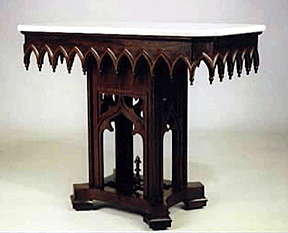 Gothic Revival
furniture followed the lines and details of Gothic architecture. A
Gothic Revival bed, like the Empire sleigh and low-post beds, had a
headboard and footboard of the same height. It usually had posts that
were solid, carved, octagonal columns attached to the headboard and
footboard. These also were solid wood and displayed arched and carved
panels. The wide sideboards were more simply carved to show Gothic
arches. A Victorian Gothic table recalled the lines of a classic Empire
table-rectangular top with ogee-molded drawer in the skirt and supports
at either end that consisted of carved columns mounted on bracket feet. Gothic Revival
furniture followed the lines and details of Gothic architecture. A
Gothic Revival bed, like the Empire sleigh and low-post beds, had a
headboard and footboard of the same height. It usually had posts that
were solid, carved, octagonal columns attached to the headboard and
footboard. These also were solid wood and displayed arched and carved
panels. The wide sideboards were more simply carved to show Gothic
arches. A Victorian Gothic table recalled the lines of a classic Empire
table-rectangular top with ogee-molded drawer in the skirt and supports
at either end that consisted of carved columns mounted on bracket feet.
If you chance upon A
Gothic Revival cupboard had cupboard below with open shelves on top,
offering a minimum of display space but framed and backed with wood
elaborately carved in more or less intricate Gothic tracery, and perhaps
embellished with finials and railings–in short, a superstructure so
fancy that nothing could be displayed advantageously on it.
Rococo Revival
The
Rococo Revival lasted longer than any other single influence during the
Victorian Era. Cabinetmakers made most of the furniture of this period.
The carvings and scrolled lines usually weren’t overdone, and as a
result the furniture was as attractive as it was comfortable.
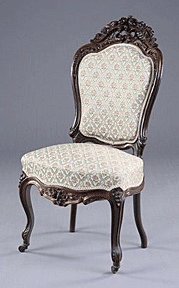 Furniture of this period
featured curved but not cabriole legs, scrolled and rounded contours
forming a cartouche back, and naturalistic carvings of roses, other
flowers, grapes, leaves, and birds. Craftsmen bent, shaped, and carved
the wood into good lines and designs. Mahogany or rosewood sofas and
chairs displayed a boldly sculptured bunch of grapes with a leaf, or a
rose surrounded by leaves. Furniture of this period
featured curved but not cabriole legs, scrolled and rounded contours
forming a cartouche back, and naturalistic carvings of roses, other
flowers, grapes, leaves, and birds. Craftsmen bent, shaped, and carved
the wood into good lines and designs. Mahogany or rosewood sofas and
chairs displayed a boldly sculptured bunch of grapes with a leaf, or a
rose surrounded by leaves.
Side chairs of this
period were comfortable as well as handsome and, as a general rule, are
better liked today than chairs of any other Victorian style. Sofas in
various lengths and love seats with upholstered wood frames were
graceful. The frame often was serpentine and always displayed some
carving, usually on the arms and back. One form of sofa had an oval or
round medallion framed in wood in the center of the back. Cabinetmakers
repeated the carving topping the medallion farther along the frame on
either side. In the 1860's, some sofas had rounded upholstered arms with
carved wood fronts. Occasionally, these arms could be let down by means
of chains to lengthen the sofa so that a person could stretch out and
take a nap-or sleep there when the house was crammed with overnight
guests.
Also popular during this
period were pairs of upholstered lady and gentleman chairs. One had a
high back and arms; the matching chair was a little lower and didn’t
have arms. The armless one was the wife's chair, convenient to sit in
while doing needlework, crocheting, or knitting. While cabinetmakers
made pairs of chairs well into the 1870's, and possibly into the 1880's,
those that followed the rounded lines of the Rococo Revival style
between 1845 and 1860 are the most attractive and least dated.
Renaissance Revival
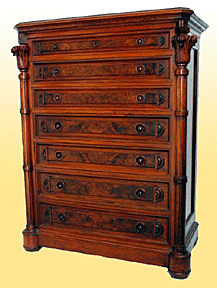 About
1855 or a couple of years later, reminders of the Renaissance began to
show up in furniture. It’s easy to distinguish a Renaissance Revival
chair or sofa from a Rococo Revival one, for the Renaissance Revival
piece looks much heavier, is more solid, and lacks curves. Cabinetmakers
made chairs for every purpose with rectangular or square seats and
rectangular backs, in contrast to the scrolled Rococo Revival lines.
Generous carving on Renaissance Revival chairs was heavier and more
elaborate, being based less on flowers, fruits, and foliage and more on
classic scrolls, knots, and the like. Some piercing appeared in the
carved areas. About
1855 or a couple of years later, reminders of the Renaissance began to
show up in furniture. It’s easy to distinguish a Renaissance Revival
chair or sofa from a Rococo Revival one, for the Renaissance Revival
piece looks much heavier, is more solid, and lacks curves. Cabinetmakers
made chairs for every purpose with rectangular or square seats and
rectangular backs, in contrast to the scrolled Rococo Revival lines.
Generous carving on Renaissance Revival chairs was heavier and more
elaborate, being based less on flowers, fruits, and foliage and more on
classic scrolls, knots, and the like. Some piercing appeared in the
carved areas.
A Renaissance Revival
sideboard was an imposing conglomeration of wood, carving, and molding.
Cabinetmakers framed the doors of the cupboards, decorated with carving,
with molding. They flanked the ends with carved columns or wide applied
molding. All Victorian sideboards had a high backboard towering over the
top surface. Renaissance Revival sideboards, in addition to being carved
in all possible places, featured a back with small shelves, railings,
and columns and was often finished off with a fancy pediment. During the
last couple of decades of the Victorian era, sideboards often had a
framed mirror along their full length, but had much less carving.
Marble, one of the great
Victorian loves, became firmly established with the Renaissance Revival.
Tables of all sizes, commodes, bureaus, and many sideboards had marble
tops. Somehow marble suited these heavy wood pieces. Cabinetmakers used
predominately white, white and gray, and pink and chocolate marble.
Neoclassic Revival
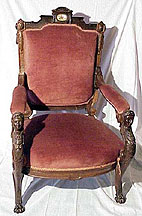 Long
before Renaissance Revival had run its course, a simpler style, called
Neoclassic or Victorian Classic, began to appear. It, too, is easy to
identify, if only because it was so much simpler and less heavily
ornamented, and hence lighter in appearance. Lines became curved again
rather than rectilinear. Scrolling wasn’t as strong nor cartouche
backs as common as they had been 20 years earlier. Actually, furniture
makers often combined elements of Neoclassic and Renaissance Revival and
perhaps Rococo Revival in one piece. Long
before Renaissance Revival had run its course, a simpler style, called
Neoclassic or Victorian Classic, began to appear. It, too, is easy to
identify, if only because it was so much simpler and less heavily
ornamented, and hence lighter in appearance. Lines became curved again
rather than rectilinear. Scrolling wasn’t as strong nor cartouche
backs as common as they had been 20 years earlier. Actually, furniture
makers often combined elements of Neoclassic and Renaissance Revival and
perhaps Rococo Revival in one piece.
Jacobean Revival
In the 1870's, furniture
makers turned to the Jacobean period for inspiration. This trend
combined with the trend toward increased amounts of factory-made
furniture led to a loss of elegance. A typical Jacobean detail was wide,
flat, ornamental molding twisted into designs. This, of course, was an
adaptation of the 17th-century Jacobean strapwork. Cabinetmakers
employed small turned spindles, not at all like the spool-turned ones,
as railings on sideboards, cupboards, whatnots, tables, and everywhere
else possible.
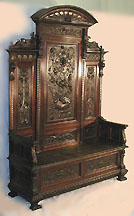 Probably the most easily
recognized piece of Jacobean Revival furniture was the whatnot. Spindles
supported its several shelves. But shelves backed with wood also might
be separated by spindles or have spindle railings. Probably the most easily
recognized piece of Jacobean Revival furniture was the whatnot. Spindles
supported its several shelves. But shelves backed with wood also might
be separated by spindles or have spindle railings.
Furniture makers didn’t
abandon carving, but they didn’t employ it in the high relief of the
earlier years. Because furniture factories produced so much furniture
now instead of cabinetmakers, shallow, incised ornamentation replaced
carving. Machines cut sprays of flowers and leaves in outline instead of
rounding them. Furniture designers monotonously repeated dots, dashes,
and other simple motifs, sometimes in combination with outlined flowers.
Beveled edges became a substitute for beautiful modeling and scrolling
of wood.
The small table made in
the 1870's and 1880's displayed a wood skirt cut gingerbread-fashion
with
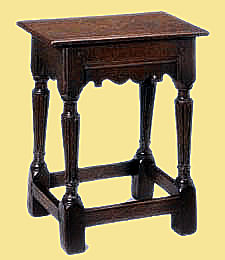 incised ornamentation. Furniture makers joined this to either a
marble or a wood top and also to one or two shelves of wood underneath.
These tables with shelves stood higher than the small tables which had
been popular in all furniture periods before or after Jacobean Revival.
The shelves were convenient for displaying some of the bric-a-brac
without which no house was complete, and were a natural development in
view of the popularity of whatnots. incised ornamentation. Furniture makers joined this to either a
marble or a wood top and also to one or two shelves of wood underneath.
These tables with shelves stood higher than the small tables which had
been popular in all furniture periods before or after Jacobean Revival.
The shelves were convenient for displaying some of the bric-a-brac
without which no house was complete, and were a natural development in
view of the popularity of whatnots.
On the whole, after 1870
all furniture became rectilinear, rigid, and solid-looking. The grace of
the Rococo Revival and Neoclassic and the distinction of Renaissance
Revival became lost in the pieces, however similar, made in the last
years of the Victorian Era. Furniture makers produced more angular
chairs and sofas which they laid with strapwork or molding, and
sometimes gingerbread.
Other Victorian Styles
By the 1870's, two other influences became noticeable in the Victorian
grab bag of styles–Oriental, chiefly Chinese, and Turkish. The
Oriental trend in a way was natural, for
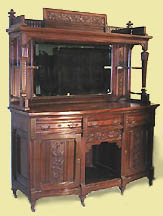 Americans had a long-standing
acquaintance with blue and white china, teakwood chests, Kashmir shawls,
and tables with fretwork carving and mother-of-pearl inlay brought by
sea captains and sailors from China and India. Late-Victorian furniture
made in the United States, however, displayed pseudo-Oriental touches.
Fretwork and Chinese-type carving did replace some of the earlier,
heavier carving. Lacquer and bamboo became popular. The Turkish
influence, however, was a purely American interpretation. Americans had a long-standing
acquaintance with blue and white china, teakwood chests, Kashmir shawls,
and tables with fretwork carving and mother-of-pearl inlay brought by
sea captains and sailors from China and India. Late-Victorian furniture
made in the United States, however, displayed pseudo-Oriental touches.
Fretwork and Chinese-type carving did replace some of the earlier,
heavier carving. Lacquer and bamboo became popular. The Turkish
influence, however, was a purely American interpretation.
Another
style of the 1870's, known as American Eastlake, was derived from the
published writings of English interior designer, John Locke Eastlake.
Furniture took on a still different look because furniture makers used
dark wood as decoration on naturally light-colored wood. To accomplish
this, they used walnut, ash, cherry, maple, chestnut, and particularly
oak in great variety rather than the long-used rosewood, mahogany, and
black walnut.
Wood in itself isn’t
necessarily indicative of any one Victorian style. Since cabinetmakers
preferred rosewood and mahogany, they used them from the beginning to
the end of the Victorian period.. About 1855 black walnut came into
favor, and continued to be used as much as rosewood.
To read
more of my articles, please
visit
my Web site.
< Back
to Antiques Articles
Next Article >
|
